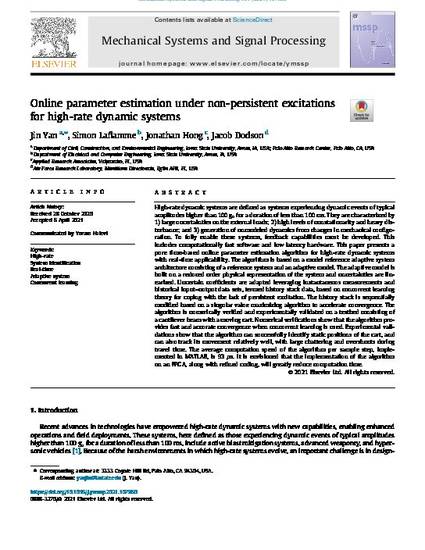
High-rate dynamic systems are defined as systems experiencing dynamic events of typical amplitudes higher than 100 gn for a duration of less than 100 ms. They are characterized by 1) large uncertainties on the external loads; 2) high levels of nonstationarity and heavy disturbance; and 3) generation of unmodeled dynamics from changes in mechanical configuration. To fully enable these systems, feedback capabilities must be developed. This includes computationally fast software and low latency hardware. This paper presents a pure time-based online parameter estimation algorithm for high-rate dynamic systems with real-time applicability. The algorithm is based on a model reference adaptive system architecture consisting of a reference system and an adaptive model. The adaptive model is built on a reduced order physical representation of the system and uncertainties are linearized. Uncertain coefficients are adapted leveraging instantaneous measurements and historical input–output data sets, termed history stack data, based on concurrent learning theory for coping with the lack of persistent excitation. The history stack is sequentially modified based on a singular value maximizing algorithm to accelerate convergence. The algorithm is numerically verified and experimentally validated on a testbed consisting of a cantilever beam with a moving cart. Numerical verifications show that the algorithm provides fast and accurate convergence when concurrent learning is used. Experimental validations show that the algorithm can successfully identify static positions of the cart, and can also track its movement relatively well, with large chattering and overshoots during travel time. The average computation speed of the algorithm per sample step, implemented in MATLAB, is 93 μs. It is envisioned that the implementation of the algorithm on an FPGA, along with refined coding, will greatly reduce computation time.
Available at: http://works.bepress.com/simon_laflamme/136/

This article is published as Yan, Jin, Simon Laflamme, Jonathan Hong, and Jacob Dodson. "Online parameter estimation under non-persistent excitations for high-rate dynamic systems." Mechanical Systems and Signal Processing 161 (2021): 107960. DOI: 10.1016/j.ymssp.2021.107960.